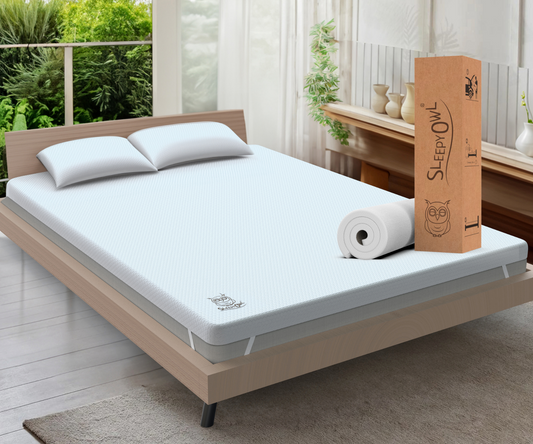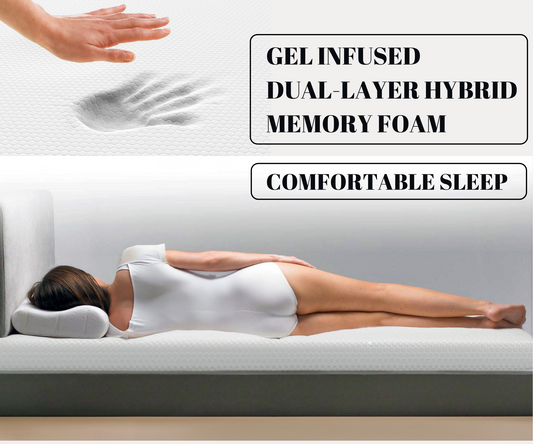Winter 2025 Sleep Tips for Cozy Nights
As the winter months approach in 2025, the importance of a good night's sleep becomes increasingly paramount. The cold weather can significantly affect our sleep patterns, making it essential to adapt our sleeping environments to ensure optimal rest. With the advent of new technologies and materials, such as memory foam, there are innovative solutions available that can enhance our sleep quality during these chilly months.
This article delves into the various aspects of winter sleep recommendations, focusing on the benefits of memory foam mattress toppers and how they can transform your sleeping experience. The winter season often brings about a host of challenges that can disrupt our sleep. Shorter days and longer nights can lead to changes in our circadian rhythms, while the drop in temperature can make it difficult to maintain a comfortable sleeping environment.
As we navigate these seasonal changes, it is crucial to consider how our bedding choices can impact our overall sleep quality. Memory foam mattress toppers have emerged as a popular solution, providing both comfort and support while adapting to the body's contours. This article will explore the myriad benefits of these toppers, alongside practical tips for creating a warm and inviting sleep space during the winter months. I recently purchased a new Memory Foam Mattress Topper for my bed.
Benefits of Using a Memory Foam Mattress Topper
Memory foam mattress toppers are renowned for their ability to provide exceptional comfort and support. One of the primary advantages of using a memory foam topper is its ability to conform to the body's shape, distributing weight evenly across the surface. This feature alleviates pressure points, which can be particularly beneficial for individuals who suffer from joint pain or discomfort.
By cradling the body in a way that promotes proper spinal alignment, memory foam toppers can significantly enhance overall sleep quality. In addition to their comfort benefits, memory foam mattress toppers also offer excellent motion isolation. This characteristic is particularly advantageous for couples, as it minimises disturbances caused by movement during the night.
When one partner shifts or gets out of bed, the other is less likely to be awakened, allowing for uninterrupted sleep. Furthermore, many modern memory foam toppers are designed with cooling technologies that help regulate temperature, ensuring that sleepers remain comfortable throughout the night, even in the colder winter months.
Factors to Consider When Choosing a Mattress Topper
When selecting a memory foam mattress topper, several factors should be taken into account to ensure that it meets your specific needs. One of the most critical considerations is the thickness of the topper. Generally, thicker toppers provide more cushioning and support, while thinner options may offer a firmer feel.
A thickness of 2 to 4 inches is often recommended for those seeking a balance between comfort and support. However, personal preference plays a significant role in determining the ideal thickness for each individual. Another important factor is the density of the memory foam used in the topper.
Higher-density foams tend to offer better support and durability, while lower-density options may feel softer but could wear out more quickly. It is also essential to consider the topper's firmness level, which can vary from soft to medium-firm. A medium-firm topper is often recommended for most sleepers, as it provides a good balance of comfort and support for various sleeping positions.
Additionally, checking for certifications such as CertiPUR-US can ensure that the foam is free from harmful chemicals and meets safety standards.
How Memory Foam Mattresses Improve Sleep Quality
Memory foam mattresses have gained popularity due to their unique properties that contribute to improved sleep quality. One of the key features of memory foam is its viscoelastic nature, which allows it to respond to body heat and weight. As a result, the material softens in response to warmth, conforming closely to the sleeper's body shape.
This adaptive quality helps reduce tossing and turning during the night, allowing for deeper and more restorative sleep cycles. Moreover, memory foam mattresses are designed to minimise motion transfer, which is particularly beneficial for light sleepers or those who share a bed with a partner. The ability of memory foam to absorb movement means that disturbances caused by shifting positions or getting in and out of bed are significantly reduced.
This feature not only enhances individual sleep quality but also fosters a more harmonious sleeping environment for couples. As a result, many individuals report experiencing fewer awakenings throughout the night and an overall improvement in their sleep satisfaction.
The Importance of Proper Sleep During the Winter Months
The significance of proper sleep cannot be overstated, particularly during the winter months when our bodies require additional rest and recovery. The colder temperatures and shorter daylight hours can lead to increased fatigue and lethargy, making it essential to prioritise quality sleep. Insufficient rest can have detrimental effects on both physical and mental health, leading to issues such as weakened immune function, increased stress levels, and impaired cognitive performance.
Furthermore, winter often brings about seasonal affective disorder (SAD), a type of depression that occurs during specific seasons, typically in response to reduced sunlight exposure. Quality sleep plays a crucial role in regulating mood and emotional well-being, making it vital for individuals experiencing SAD to create an environment conducive to restful slumber. By investing in comfortable bedding solutions like memory foam mattress toppers and prioritising sleep hygiene practices, individuals can combat the negative effects of winter on their overall health.
Tips for Creating a Cozy Sleep Environment in 2025
Creating a cosy sleep environment is essential for promoting restful slumber during the winter months. One effective strategy is to optimise bedroom temperature by keeping it cool yet comfortable. The ideal sleeping temperature typically falls between 16-20 degrees Celsius (60-67 degrees Fahrenheit).
Using flannel sheets or thermal bedding can help retain warmth while still allowing for breathability. In addition to temperature control, incorporating soft lighting can enhance the overall ambience of your bedroom. Dimming lights in the evening signals to your body that it is time to wind down, promoting relaxation and preparing you for sleep.
Consider using blackout curtains or eye masks to block out any external light sources that may disrupt your slumber. Furthermore, adding personal touches such as warm blankets or decorative pillows can create an inviting atmosphere that encourages restful sleep.
The Role of Memory Foam in Regulating Body Temperature
One of the lesser-known benefits of memory foam is its ability to regulate body temperature during sleep. Traditional memory foam has been critiqued for retaining heat; however, advancements in technology have led to the development of cooling gel-infused memory foam toppers that address this issue effectively. These innovative materials are designed to dissipate heat away from the body while still providing the contouring support that memory foam is known for.
The cooling properties of these modern memory foam toppers are particularly beneficial during winter when indoor heating can create an overly warm sleeping environment. By maintaining an optimal temperature throughout the night, these toppers help prevent overheating and promote uninterrupted sleep cycles. This temperature regulation not only enhances comfort but also contributes to improved overall sleep quality.
How to Select the Right Memory Foam Mattress Topper for Your Needs
Selecting the right memory foam mattress topper involves careful consideration of various factors tailored to your individual preferences and requirements. Begin by assessing your current mattress's condition; if it is too firm or lacks support, a thicker topper may be necessary to provide additional cushioning. Conversely, if your mattress is relatively new but simply needs a touch of softness, a thinner option may suffice.
Next, consider your sleeping position when choosing a topper. Side sleepers often benefit from softer toppers that alleviate pressure on shoulders and hips, while back and stomach sleepers may prefer firmer options that maintain spinal alignment. Additionally, take into account any specific health concerns you may have; for instance, individuals with allergies should look for hypoallergenic materials that resist dust mites and other allergens.
The Impact of Winter Sleep on Overall Health and Wellbeing
The impact of winter sleep on overall health and wellbeing extends beyond mere fatigue; it encompasses various aspects of physical and mental health. Quality sleep is essential for maintaining a robust immune system, particularly during winter when colds and flu are prevalent. Insufficient rest can compromise immune function, making individuals more susceptible to illness.
Moreover, adequate sleep plays a vital role in cognitive function and emotional regulation. During winter months when daylight is limited, many individuals experience mood fluctuations or increased anxiety levels. Prioritising restful sleep through effective bedding solutions like memory foam mattress toppers can help mitigate these effects by promoting emotional stability and enhancing cognitive clarity.
Incorporating Memory Foam Pillows for Enhanced Comfort and Support
In addition to memory foam mattress toppers, incorporating memory foam pillows into your sleep setup can further enhance comfort and support during winter nights. Memory foam pillows are designed to contour to the head and neck's natural curvature, providing optimal alignment for spinal health. This feature is particularly beneficial for individuals who experience neck pain or discomfort due to improper pillow support.
When selecting a memory foam pillow, consider factors such as loft height and firmness level based on your preferred sleeping position. Side sleepers may benefit from higher loft pillows that fill the gap between the shoulder and head, while back sleepers might prefer medium loft options that maintain alignment without excessive elevation. By pairing a quality memory foam mattress topper with an appropriate pillow, you can create a comprehensive sleep solution that addresses all aspects of comfort and support.
Embracing the Benefits of Memory Foam for Winter Sleep in 2025
As we embrace the winter months of 2025, prioritising quality sleep becomes increasingly important for our overall health and wellbeing. Memory foam mattress toppers offer an array of benefits that enhance comfort while addressing common sleep challenges associated with colder weather. By understanding how these toppers work and considering factors such as thickness and density when selecting one, individuals can make informed choices tailored to their unique needs.
Incorporating additional elements such as memory foam pillows further enhances this experience by providing comprehensive support throughout the night. As we navigate through winter's challenges, creating a cosy sleep environment equipped with innovative bedding solutions will undoubtedly contribute to improved restfulness and rejuvenation during this season.
FAQs
What are the recommended hours of sleep for adults in 2025?
In 2025, the recommended hours of sleep for adults remain the same as previous years, which is 7-9 hours per night.
Are there any changes in sleep recommendations for children and teenagers in 2025?
As of 2025, the sleep recommendations for children and teenagers have not changed. It is still recommended that children aged 6-12 get 9-12 hours of sleep per night, while teenagers aged 13-18 should aim for 8-10 hours of sleep per night.
What are the benefits of getting enough sleep in 2025?
Getting enough sleep in 2025 continues to be associated with numerous health benefits, including improved cognitive function, better mood regulation, and a strengthened immune system. Adequate sleep also plays a crucial role in maintaining overall physical and mental well-being.
What are the potential risks of not getting enough sleep in 2025?
In 2025, the potential risks of not getting enough sleep remain the same, including an increased risk of developing chronic health conditions such as obesity, diabetes, and heart disease. Insufficient sleep can also negatively impact cognitive function, mood, and overall quality of life.
How can individuals improve their sleep quality in 2025?
In 2025, individuals can improve their sleep quality by establishing a consistent sleep schedule, creating a relaxing bedtime routine, and ensuring their sleep environment is conducive to rest. Limiting screen time before bed and avoiding stimulants such as caffeine and nicotine can also contribute to better sleep quality.


